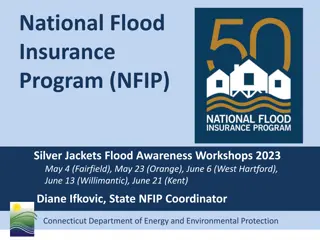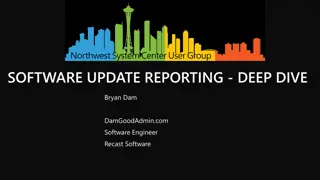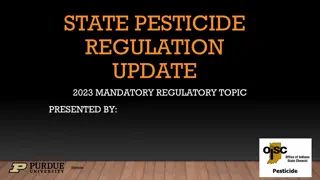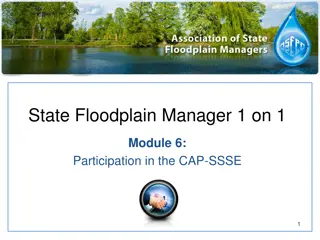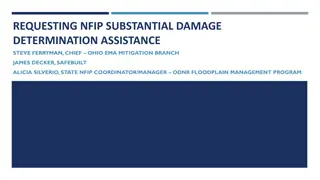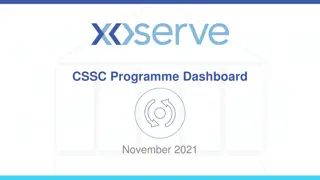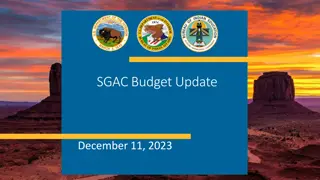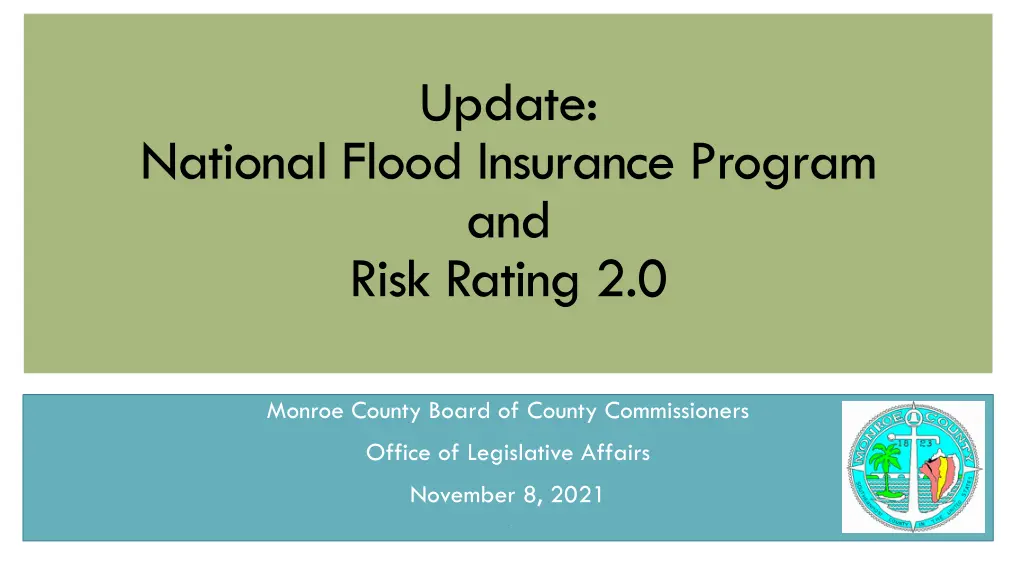
NFIP Risk Rating 2.0 Impact in South Florida
Understanding the significant changes brought by Risk Rating 2.0 to the National Flood Insurance Program (NFIP) and its impact on policyholders in South Florida, specifically in Monroe County. The new methodology by FEMA aims to provide more accurate property-specific risk assessment for premium calculations. Learn about the implications, rate changes, and early analysis of how this affects policyholders in the region.
Download Presentation

Please find below an Image/Link to download the presentation.
The content on the website is provided AS IS for your information and personal use only. It may not be sold, licensed, or shared on other websites without obtaining consent from the author. If you encounter any issues during the download, it is possible that the publisher has removed the file from their server.
You are allowed to download the files provided on this website for personal or commercial use, subject to the condition that they are used lawfully. All files are the property of their respective owners.
The content on the website is provided AS IS for your information and personal use only. It may not be sold, licensed, or shared on other websites without obtaining consent from the author.
E N D
Presentation Transcript
Update: National Flood Insurance Program and Risk Rating 2.0 Monroe County Board of County Commissioners Office of Legislative Affairs November 8, 2021 oIf
RECAP of NFIP Nationally, 5M policies, $4.6B in rev from policy holders premiums, $1.3T in coverage. Florida 1.7M policies, $974M in premiums paid, $440B in total coverage. Florida has the most NFIP policies in the country and the most at stake with changes to the NFIP, including any changes that negatively impact policy holders, such as increased premiums. NFIP is a federal program that must be authorized by Congress. By federal law the program must be reauthorized every five years. Last big reauthorization and reform efforts passed by Congress: Biggert Waters (2012) and Homeowner Flood Insurance Affordability Act (HFIAA) (2014) Current important provision glide paths: 18% (primary res) and 25% for second homes, commercial, SRL props (current annual increases are about 11%.) 18 extensions since 2014 NFIP currently authorized through Dec. 3. Most likely another short-term extension after.
Risk Rating 2.0 ** RISK RATING 2.0 IS ONE OF THE MOST SIGNIFICANT CHANGES TO NFIP SINCE ITS INCEPTION ** FEMA s new methodology for rating the risk of each property to determine their NFIP premium amount. MUCH more granular than current flood zones. Property specific. Includes many more flood risk variables. Per FEMA it will captures the true risk of properties, and assigns a more accurate risk-based insurance cost. RR 2.0 will account for: Proximity to coast/river/water body Structural (construction/foundation types) Building elevation (using FEMA s internal data sets not ECs.) Propensity for storm surge, excessive rainfall. Frequency of flooding Cost to rebuild # of Prior claims Former rating accounted for: BFE (ECs are encouraged) Flood zone on flood map 1% chance of flooding
Risk Rating 2.0 continued ** NEW RR 2.0 RATES TO GO INTO EFFECT OCT 2021 FOR NEW POLICIES, AND APRIL 2022 FOR EXISTING POLICIES ** Noproperty level premium information has been released yet; only State level data is available. In the past month or so, zip code level data was released. Per FEMA: 1.1M policies will stay about the same; 200K policies will increase; 340K policies will decrease. RiskRating 2.0 State Profiles | FEMA.gov (for your county and zip code level) New premiums will not be able exceed the statutory limits on annual increases. CRS discounts will continue to apply to all policies.
Risk Rating 2.0 continued Early analysis of RR 2.0 impacts on Monroe County s rate differ significantly from FEMA s projections. Over 90% of policy holders will see increases, with an average annual of $3,200. Almost all properties with an Elevation Certificate had lower premium calculations.
NFIP Policies in South Florida- What s at stake for our communities? ** FLORIDA S POLICY HOLDERS AND ESPECIALLY THOSE IN THE COUNTIES OF MIAMI DADE, BROWARD AND MONROE -- HAVE THE MOST AT STAKE WITH THE CHANGES TO NFIP S RISK FACTORS AND PREMIUM CALCULATIONS.** With 1.7M policies, Florida is most impacted state. In Florida, these counties are most impacted: MD County: 342K policies, $76B in coverage (most policies and highest coverage in State.) Broward County: 210K policies, $52B in coverage (second highest polices and coverage in State.) Palm Beach County: 140K policies, $38B in coverage Monroe County: 30K policies, $7B in coverage (highest percentage of properties insured with NFIP.)
What is happening now? Legislative activity: 2020 Financial Services Chair proposed legislation that would limit annual flood insurance rate increases to 9 percent. Infrastructure and BBB bills include provisions for NFIP: funding for an affordability program, mapping, debt forgiveness ($25B), resiliency. Nov 2, bipartisan legislation was introduced in the Senate to reauthorize the NFIP: the National Flood Insurance Program Reauthorization and Reform Act National Flood Insurance Program Reauthorization Act (Co-sponsored by Sen. Rubio.) You can view the legislation here and a section-by-section summary here. Very similar to 2019 SAFE-NFIP. The bill contains several provisions that have been advocated by us: Five-year authorization of the NFIP Caps annual premium increases at 9% Freezes interest payments on the NFIP debt and reinvests that savings towards mitigation efforts Increases ICC CONTACT YOUR FEDERAL ELECTED OFFICIALS REGARDING YOUR CONCERNS ABOUT INCREASING PREMIUMS AND ASK THEM TO SUPPORT THESE EFFORTS
Whats happening now? Agency Level Activity: FEMA Requests for Information indicate the potential for significant changes to NFIP, aside from premiums. Current RFI seeks public input on updating/increasing NFIP s floodplain management standards. Questions relate to: Expanding the flood plain, new elevation requirements, factoring in climate change to mapping, prohibiting critical structures in flood plains, changes to RL props and substantial damage metrics. Responses/comments are due Dec 13, 2021. The notice information and the place to submit comments: Regulations.gov PAY ATTENTION TO ANNOUNCEMENTS OF FEMA NFIP AND FLOOD PLAIN RELATED AGENCY ACTIONS AND RESPOND WITH WRITTEN COMMENTS.
What to do? Policy holders should get an elevation certificate. (FEMA s data that is informing its new rating scheme is likely inaccurate and/or not favorable. Folks need to get their own elevation data.) Policy holders should talk to their insurance agent, and ask them about how your specific premium will be impacted. Don t have to wait until April. All stakeholders should stay informed, the situation is evolving. Local govt staff should carefully monitor FEMA announcements, RFIs, public meetings -- and respond. Ensure coordination btw technical and legislative/policy/political staff. ** All stakeholders should talk to their federal legislators, share concerns/urgency about RR 2.0 - - ask them to support a 10% or less cap on annual increases to premium.** Remember: Participating and advancing within in the Community Rating System (CRS) can help with reducing flood insurance rates as communities will continue to earn National Flood Insurance Program rate discounts of 5%-45%, based on their community classification.


